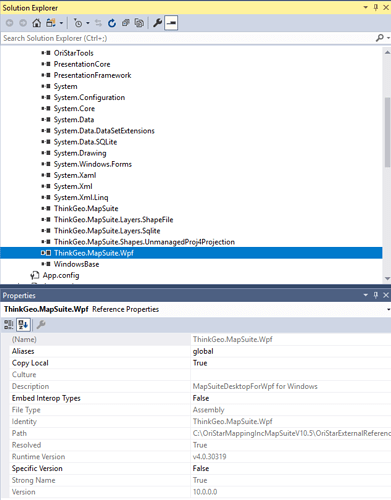MapSuite Team,
I have an application that is nearly eight years old, which incorporates the MapSuite SDK for rendering a map and another 3rd party SDK for other real-time information. Up until now these two SDK’s have not interfered with each other.
I recently upgraded this application from MapSuite V10.0 to V10.5 and now find that ThinkGeo.MapSuite.Wpf.dll V10.5.6 is interfering with the other 3rd party SDK.
The other SDK acts as a client that connects to its server. When ThinkGeo.MapSuite.Wpf.dll V10.5.6 is used the other SDK is unable to connect to its server. The prior version I’ve been using is ThinkGeo.MapSuite.Wpf.dll V11.0.0-beta044. When this version is used the other SDK has no problem connecting to its server.
It would appear that there is something in ThinkGeo.MapSuite.Wpf.dll V10.5.6 that is ‘interfering’ with the network. The other SDK is using network port 5500 for its initial communication between client and server. The behavior of the other SDK is suggestive of something blocking/preventing communication on port 5500.
I have another application which uses a small number of MapSuite DLL’s, which does not render a map. It is only used to build SQLite Feature Layers. This application also incorporates the other 3rd party SDK. The following MapSuite DLL’s are referenced:
NetTopologySuite.dll
ThinkGeo.MapSuite.dll
ThinkGeo.MapSuite.Layers.ShapeFile.dll
ThinkGeo.MapSuite.Layers.Sqlite.dll
MapSuiteDependency-UnmanagedProj4Projection.dll
ThinkGeo.MapSuite.Wpf.dll
When referencing the V10.0 DLL’s and ThinkGeo.MapSuite.Wpf.dll V11.0.0-beta044 the other SDK is able to connect to it’s server.
After upgrading this application from MapSuite V10.0 to V10.5 and ThinkGeo.MapSuite.Wpf.dll V10.5.6 the other SDK is unable to connect to its server.
This application actually does not require ThinkGeo.MapSuite.Wpf.dll since it does not render a map. So I removed the reference to this DLL and the vestigial using ThinkGeo.MapSuite.Wpf statements. After removing the reference and rebuilding the application the other SDK can now connect to its server.
The mere reference to ThinkGeo.MapSuite.Wpf.dll V10.5.6 in this application ‘interferes’ with the other SDK.
So the question is “what is inside ThinkGeo.MapSuite.Wpf.dll V10.5.6 that is causing this interference” ?
I realize this is a lot to absorb, but please read over and give it some thought.
Regards,
Dennis
P.S.
For my application that uses both SDK’s I reverted back to these two DLL’s and now the application works with the other SDK connecting to its server:
ThinkGeo.MapSuite.Wpf.dll V11.0.0-beta044
ThinkGeo.MapSuite.dll V11.0.0-beta057





